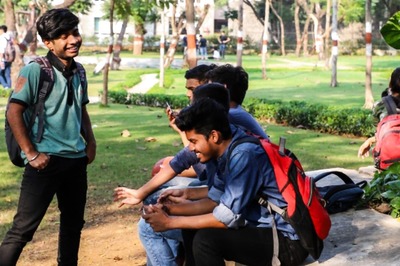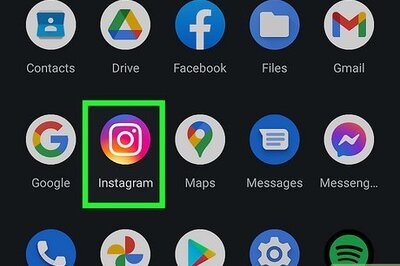
views
Shanghai: At 26, Wu Yi's cancer was spreading. His doctor gave him five years to live and a prescription for OxyContin.
Six years later, he was still alive. And still taking OxyContin. Wu said his doctor told him that OxyContin is not addictive, but when Wu tried to stop, he couldn't.
“This drug is addictive,” Wu said.
A thousand miles away, in the ancient trading city of Xi’an, Yin Hao popped in eight pills of Tylox, a combination painkiller that contains the opioid oxycodone. Yin had started taking Tylox after getting injured in a fight six years earlier.
“Do you know how much I don’t want to take drugs?” he said. “My mouth says don’t take it, but my body is more honest and figures out a way to get it.”
Both Wu and Yin fell into opioid abuse the same way many Americans did, through a doctor’s prescription. But officially, in China, they don’t exist.
Addicts like Wu and Yin struggle in the shadows of a system that offers few treatment options and fails to count them in official statistics on drug abuse, the Associated Press found.
As the backlash against opioid painkillers drove down US consumption, pharmaceutical companies began chasing profits in places like China, Australia and Europe using the same controversial sales tactics they did in North America. In 2017, more than half the doses of five major opioid painkillers went to countries other than the US and Canada, the first time that has happened since at least 2000, data from the International Narcotics Control Board shows.
Chinese officials have blamed out-of-control demand and poor oversight for the US opioid epidemic, discounting the role of Chinese supply. Meanwhile, painkiller addicts in China remain largely invisible and, despite strict regulations, can turn to online black markets for opioids and other prescription drugs. The AP found previously unreported trafficking of OxyContin and Tylox on e-commerce and social media platforms run by China’s largest technology companies.
Only 11,132 cases of medical drug abuse were reported in China in 2016, according to the most recent publicly available national drug abuse surveillance report. But reporting is voluntary and drawn from a small sample of institutions including law enforcement agencies, drug rehabilitation centers and some hospitals.
Hao Wei, president of the Chinese Association of Drug Abuse Prevention and Treatment, said he believes abuse of prescription opioids is limited in China, but added that official data largely overlooks prescription drug abuse.
“What is recorded is the tip of the iceberg,” he said.
A Visit from God of Death
Wu was diagnosed with lymphoma in October 2013.
Cancer transformed Wu from a baby-faced boy to a sallow wraith immobilized on a gurney. Doctors cut chemotherapy short after he developed an infection, he said, and his existence narrowed to a single, searing reality: Pain.
For six months, Wu lay in bed. Strange bulges, filled with pink fluid, appeared on his legs. It felt like his bones were swelling until they were ready to burst.
Wu said a doctor at Sun Yat-sen University Cancer Center in the southern Chinese city of Guangzhou gave him his first prescription for OxyContin in 2014, telling him he could take as much as he wanted.
As a late-stage cancer patient, Wu was exactly the kind of person OxyContin was meant to help. And the pills brought him relief. But even as the US death toll from opioid overdoses approached 400,000, no one in China warned Wu about addiction risks, he said, neither his doctor nor the nurses or the drug company sales representative.
The sales rep told AP she worked for Mundipharma, a Chinese company that is owned by the Sackler family, which also owns Purdue Pharma, the American company whose sales of OxyContin allegedly helped drive the US opioid crisis. She told AP she has left Mundipharma but confirmed she used to visit some patients in the hospital. She refused to discuss further details. Three other former Mundipharma employees also told AP they regularly visited patients in the hospital, sometimes disguising themselves as doctors.
A doctor from Sun Yat-sen University Cancer Center told AP that sales reps are not allowed to visit patients. He said he warns patients about OxyContin’s abuse risks but acknowledged not all doctors do. He spoke on condition of anonymity because he was not authorized to talk with foreign media.
In a statement to AP, Mundipharma denied that sales staff visit patients and said it has checks and balances in place to “ensure strict compliance with medical protocols, laws and regulations.”
Sun Yat-sen University Cancer Center did not respond to requests for comment.
The Pickaxe
Yin Hao, who also goes by Yin Qiang, struggled to remember life before pain pills. He thought back to when was 21 years old, strong and wiry, working at a nightclub. He had knock-off Burberry sheets, a mortgage in his name, and a girl he planned to marry.
Then one night in 2013, he and his friends got into a fight with some older, richer guys, and someone drove a pickaxe into his waist.
The hospital sent him home with four boxes of Tylox, a combination of acetaminophen and oxycodone, the active ingredient in OxyContin. Tylox is manufactured by SpecGx, a subsidiary of Mallinckrodt, which has faced lawsuits in the US accusing it of helping stoke the opioid abuse crisis.
Mallickrodt has denied the allegations.
Yin said his doctor didn’t tell him the medicine could be addictive. Within six months, he was taking 30 pills a day.
Yin needed more and more pills to function. He opened dozens of accounts with online pharmacies to buy Tylox. Many didn’t require a prescription. Once he wrote a three-character Chinese profanity on a piece of paper and uploaded a photo of that instead of a prescription. The pills came anyway, he said. He figured pharmacies wanted the sale almost as much as he wanted the drugs. His excessive consumption didn’t trigger any alarms.
Yin lost 60 pounds. He wondered if his kidneys would fail and was convinced Tylox had changed the color of his eyes. “My nerves are a mess, my bones are misplaced and I have become lazy, irritable, extreme,” he said. “Experts say that if you take this medicine because of pain, it’s not addictive. This is rubbish.”
Just Chew it
In early 2016, a doctor told Wu the cancer had come back. He signed an organ donation form, and posted it on social media with a message: “Although I don’t know when the journey of life will end, when that moment comes, I will leave behind a bunch of flowers, roses that blossom from my body.”
The proximity of death clarified Wu’s ambition. He had dropped out of school at fifteen and hustled to start a catering business, which collapsed when he got sick.
Now, Wu dreamed of leaving his parents’ home in Yangjiang, a coastal city in southern Guangdong province, and moving to Shenzhen, China’s dazzling southern boom town, to make music.
By 2018, Wu’s cancer was in remission and he could walk with a crutch. The pain was under control, but he kept taking OxyContin. “Once you take that drug, I’ve said it, it’s just like going home,” he said. “There’s a sense of belonging and safety.”
But the longer Wu took the pills, the less effective they were, he said. Wu started taking OxyContin with a half bottle of strong Chinese liquor, which he had delivered secretly to his house.
He also noticed the package insert for OxyContin says not to chew it, which releases the active ingredient, oxycodone, all at once rather than over time. Chewing the pills made them hit with more intensity. “As long as you try chewing it once, there’s no way for you not to chew it the next time,” he said.
More Terrible Than Ghosts
Yin had vowed dozens of times to quit Tylox. He tried ice baths, saunas, and Russian vodka. He took a fistful of an antipsychotic that made him feel like his heart had stopped. He went to hypnosis and consulted cheap doctors online.
Yin said he’d gone to hospitals for help, but doctors around Panjin, the town in northeastern China where he lived with his grandparents, didn’t seem to know what withdrawal was. Some told him to go to a psychiatric hospital; others prescribed more Tylox, he said.
Once he rented a hotel room in the northeastern city of Dalian, shackled his leg to the radiator and threw the key out the window, he said. He binged on horror movies and cigarettes to distract himself and spent a few sweaty, aching hours alone, writhing in a bed that felt like it was made of fire. Then he broke the lock on his shackles, ran to a pharmacy and bought more Tylox.
On March 6, Yin woke up at 6 am determined to go cold turkey. It hurt to chew. He soaked biscuits in water and gummed them; a little while later, they were diarrhea.
“I used to be afraid of ghosts, but now I think this is more terrible than ghosts,” he said.
Block Market
Wu’s family had poured out all their meager fortune to pay his medical bills. He said health insurance had covered roughly 30 to 60 percent of the cost, depending on where he got treatment. To pay the rest, the family sold their house in August 2014. His parents, who planted orange trees before he got sick, picked up short-term jobs, like cleaning restaurants.
As 2018 rolled into 2019, Wu was still spending 1,500 yuan ($215) a month on OxyContin. His parents told him he was poisoning himself and started locking up his pills.
In April, he again swore to his family he would stop. Instead, he secretly spent his last 2,000 yuan on OxyContin.
When he went to the hospital to pick up his pills, he signed consent form that instructed him not to give the medicine to anyone else, but did not warn about the risk addiction or abuse, a copy of the signed form shows.
Wu trolled internet forums for cheaper, second-hand OxyContin. He joined an online community of opioid dealers and abusers, and grieving family members eager to get rid of left-over pain medicine.
Wu left his contact information in a thread about OxyContin on Tianya, an internet forum. He said someone offered him OxyContin left over after a family member died, but he decided to stay focused on surviving on four pills a day, down from six.
In the U.S., online sales fueled the spread of opioid abuse. Major tech platforms, including Facebook and Twitter, have struggled to purge themselves of illicit listings.
China has some of the strictest regulation of opioids in the world, which many believe will prevent a U.S. style addiction outbreak. But AP found illicit trafficking of opioids on the open internet in China as well.
In a brief survey, AP identified thirteen active vendors selling OxyContin and Tylox on Tencent’s popular WeChat and QQ platforms, Alibaba’s second-hand marketplace Xianyu, Baidu’s Tieba forum, as well as Sina Corp.’s Weibo microblogging site and Zhuan Zhuan, another second-hand marketplace. Vendors often used one platform to find customers and another to execute sales. In addition, Tianya had dozens of posts from people selling or seeking OxyContin over the past few years.
The AP did not make any purchases and could not confirm the authenticity of the pills.
“Mundipharma China has no knowledge of the diversion of its products on ecommerce and social media platforms,” the company said in a statement to AP.
Mallinckrodt's specialty generics subsidiary SpecGx sells its pain pills to a Chinese importer. In a statement, the company said it "has no manufacturing, distribution, sales force or in-country presence in China.”
Alibaba’s Xianyu, known as Idle Fish in English, said it removed listings that violated marketplace policies after AP pointed out illicit opioid sales. The company said it prohibits “illegal behavior by third-party sellers on the platform.” Sina Corp., which runs Weibo, said that after finding violations, it ran a campaign in March to clean-up illicit content about medicines and medical equipment. Xianyu, Tencent, Baidu and Sina Corp. all said they actively monitor their platforms and encourage users to proactively report illicit activity.
Tianya and 58.com, which runs Zhuan Zhuan, didn’t respond to requests for comment.
Its Good I Don't Die
On April 28, Wu ran out of money and stopped taking OxyContin. The fact that he was alive the year after he was supposed to be dead gave him hope. “I’m still young,” Wu said. “I have a lot of things to do.”
Four days later, he told a doctor at Yangchun People’s Hospital he couldn’t stop taking OxyContin and hadn’t slept in days. He left with a prescription for benzodiazepine sleeping pills and a warning not to take more than three at a time. He took 15.
The next day, he went back for more, but the doctor didn’t want to give him more than day’s supply. Wu lay on the hospital floor and refused to budge.
“I am suffering so much,” he called out. “Why do you treat me like this?’”
Wu said he managed to get more sleeping pills that week by visiting different doctors. He’d take 20 or more at a time. The pills stunned him, he said, but didn’t put him to sleep. At night, he’d just fall down, unconscious.
“It’s good I didn’t die,” he said.
Doctors at Yangchun People’s Hospital eventually cut him off and told him to go to a mental hospital, he said.
Yangchun People’s Hospital did not respond to requests for comment.
On May 29, Wu got his brain scanned at the Yangchun Minfu Psychiatric Hospital, medical records show. Doctors there first told Wu he was suffering from schizophrenia, then changed their diagnosis to depression, he said.
Wu didn’t believe he was mentally ill. He said he told doctors he was going through opioid withdrawal. He said he was given an anti-depressant and an anti-psychotic.
A man who picked up the phone at Yangchun Minfu Psychiatric Hospital said the facility has no addiction treatment program and had never dealt with prescription pill abuse. He refused to give his name and hung up the phone.
Wu’s body began to swell. Terrified his cancer was back, he checked into the oncology ward of Yangchun People’s Hospital on June 15. A blood test came back clean, he said. His cancer was still in remission.
By the end of June, the worst of the withdrawal symptoms were gone.
The World Without Him is an Abyss:
Despite the officially low numbers of pill addicts, the Chinese government was concerned enough about painkiller abuse that in September it pulled combination opioid painkillers, including Tylox, from most pharmacies.
On September 18, Yin Hao posted an elegy to Tylox on WeChat. The world without Tylox, he wrote, “is an abyss.”
He said he was taking more than 100 Tylox pills a day, which added up to over 500 mg of oxycodone and 32,500 mg of acetaminophen. The U.S. Centers for Disease Control says a dose of just 33 mg of oxycodone a day doubles the risk of overdose. Taking more than 4,000 mg of acetaminophen daily can result in severe liver damage and death.
Before the new regulations took effect, it was easy to get Tylox from pharmacies in certain cities and online without a prescription. Earlier this year, AP identified five pharmacies selling Tylox without a prescription. In addition, three of six online pharmacies that said they had Tylox in stock sold it without a prescription, AP found.
A month after the new rules took effect, Yin had just two pills left. He thought about committing a crime or using harder drugs so the police would force him into a mandatory detox center.
By November Yin’s pill box was full again. He claimed he was able to buy Tylox illegally from some online pharmacies. He said he lied to doctors at hospitals to get more pills, though not everyone fell for it.
Yin said he got Tylox sales agents to sell him bulk pills directly and bribed a courier not to examine his packages. He declined to share their names with AP, and it was impossible to verify his claim.
Sometimes Yin worried police were following him. He didn’t want to go to prison, he said. He wanted to go to rehab.
If he could unspool his life and wind it up again, Yin said the second time round he would take pain instead of Tylox.




















Comments
0 comment